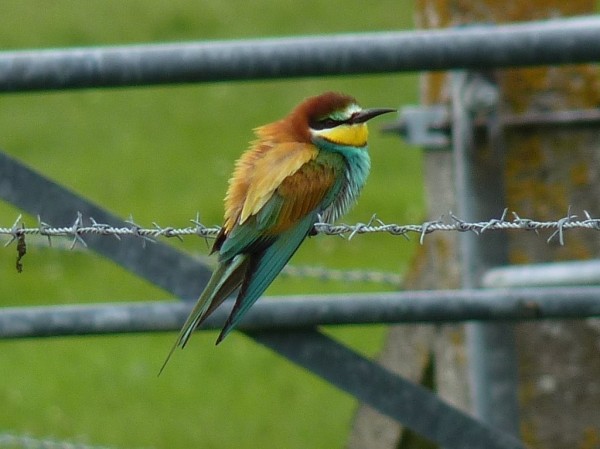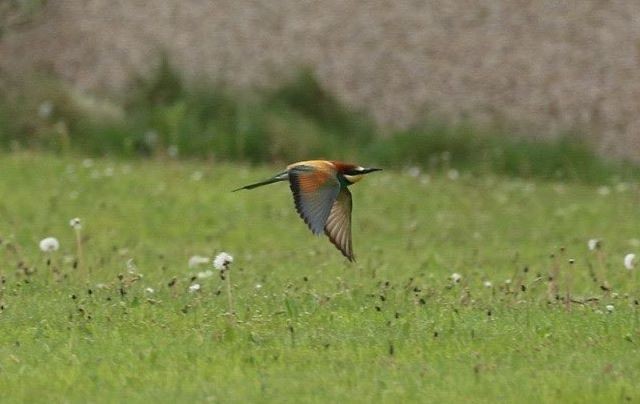First birds on the list in May were 3 Bonxies at Newark Bay where Phil Longley spied 2 Arctic Terns on this day also. More reports from Newark include 6 Dunlin and 2 Sanderling at the slip, I saw a tiny Willow Warbler fly out of the Rosa Rugosa near the car park. There are Eider chicks at the Geo - seven at last count but it's a hazardous life for them with many predators around.
It's worth a visit to Newark Bay just now as the rare Oyster Plant is making a particularly good showing this year and the blue flowers are beginning to appear. A walk along the beach will reveal a number of clumps to be admired.
We have an assortment of hirondelles in Deerness! Firstly Swallows are making themselves at home in barns and other buildings throughout the area. Once again the Deerness shop building is host to a family of Swallows. Nancy Scott tells me that House Martins have returned from their travels and are nesting at two spots under the eaves once more. Finally Sand Martins are back in the area near the old chapel just below Marlene and Ivor Rorie's house at Newark. More Sand Martin news from Jonathan and Kathryn Southerington that birds have made homes in a sand bank kindly provided by John Petrie due to excavations.
Here at Sunnybank I was watching 3 Jackdaws trying to use the bird feeder on May 24th; a nice colourful male Linnet on the front fence; the Starling and Sparrow nestboxes are all occupied and the garden wall echoes with chirps! A Blackbird has chosen a shelf in the greenhouse to call home for her brood. A particularly nice sighting - if only a fleeting look - was a trio of Siskins on the peanut feeder. Two were striking males together with a female.
One bird you cannot fail to see is the Meadow Pipit which seems to be everywhere just now and can often be seen carrying food for chicks in the nest. Quite a number at Newark this year. Of course the Skylark cannot be ignored as it soars skywards in loud song. They too will have chicks just now as will most breeds. Lapwings, Oystercatchers, Redshank can all be seen and heard defending their families from predators. Last month I said I was disappointed not to have heard a Snipe drumming but I was pleased to at last hear Snipe in the East Denwick and Sandside areas. Such an unforgettable sound as the wind rushes through the tail as the bird descends!
There have been quite a number of migrant birds around - Ian Cunningham reports Chiff Chaff and Willow Warbler at Lighthouse Quarry gardens; Alan Leitch heard a Cuckoo at East Denwick. A ringing session at this location produced a nice Spotted Flycatcher, a Willow Warbler and a Goldcrest. The dog and I had a walk at Sandside and was thrilled to watch a Pied Flycatcher flying up the burn area; Isobel Gardner rang to say she had been watching a female Whitethroat dive bombing into Lady's Mantle just outside the window! I would have liked to have seen this!
During a walk up by East Denwick an Arctic Skua flew overhead. I understand this species is not faring too well so it was a nice sighting.
However, the star of the month must surely be the BEE EATER which was spotted by Stuart and Mary Wylie at Lighthouse Corner. Stuart kindly rang me and the bird obligingly posed for a photograph. As a bonus, Stuart actually saw the bird eating a bee - apparently they are able to remove the sting before they do so! Stuart was happy for people to see this rarity so a number of folk turned up to catch a glimpse of the colourful bird.
(Photo of Bee Eater by Pauline Wilson - Photo of flying Bee Eater by Christine Hall.)
Well I can't really follow that. When the month of May started the verges were bright yellow with Dandelions providing a welcome early feed for bees. It will be a different story for June as wildflowers really get into their stride!
Pauline Wilson

